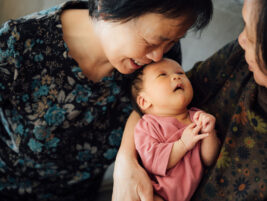Early relationships with caregivers are the foundation for infant mental health. Yet the study of parent-infant interaction has been almost exclusively shaped by Euro-American caregiving norms emphasizing visual face-to-face interaction, verbal responsiveness, and positive emotional display as core indicators of early relational health. Most tools used in assessment and clinical practice reflect these assumptions. These frameworks represent only a small portion of how infants are raised globally. In many caregiving environments around the world, infants are held close to the caregiver’s body, and communication unfolds through movement, breath, posture, and rhythm.
This paper proposes a shift in how infant mental health is conceptualized. Rather than framing variation from face-to-face interaction as divergence or risk, I highlight proximal caregiving (i.e., body-to-body contact through infant carrying, bed-sharing, and long periods of sustained physical contact) as a widespread, developmentally meaningful, and enriching caregiving context. I highlight findings from randomized trials, cross-cultural comparisons, and observational studies to demonstrate how touch-based engagement supports early co-regulation, emotional expression, and caregiver sensitivity.
Much of the current literature on infant social development relies on tools that measure visual and vocal interaction. The Still-Face Paradigm (SFP) is among the most widely used of these tools. It is designed to examine infants’ expectations for contingent interaction by assessing their responses to a temporary pause in face-to-face engagement (Tronick et al., 1978). Standard measures include gaze aversion, facial affect, and vocal protest. The pattern observed in urban U.S. samples (i.e., reduced positive affect and increased distress) is often used as a benchmark. However, research in global contexts challenges these conclusions. In a cross-cultural study, Bolivian infants, who were raised in proximal care environments characterized by near-constant physical contact, showed no significant change in behavior during the still-face episode while U.S. and Fijian infants displayed the expected signs of distress (Broesch et al., 2022). These findings suggest that infants develop expectations for social interaction based on their cultural environment. What appears as disengagement through the lens of Western paradigms may instead reflect self-regulation or relational trust.
This is supported by observational data comparing infant-caregiver object exploration in the U.S. and Vanuatu. Caregivers in Vanuatu engaged infants through physical positioning and touch, rather than through pointing or verbal explanation (Little, Carver, & Legare, 2016). The structure of interaction reflected a relational model in which infants learn through physical proximity and shared movement. A follow-up experimental study (Little, Legare, & Carver, 2022) found that U.S. parents randomly assigned to wear their infants in soft carriers were more responsive during interactions than those who used stationary infant seats. Physical contact increased parental sensitivity without requiring changes in instruction or training. In carried positions, caregivers can detect subtle shifts in temperature, breath, or body tone and infants learn through alignment with caregiver rhythms, often appearing calmer and more observant. These patterns have physiological benefits: in a randomized controlled trial, caregivers who received infant carriers were significantly more likely to continue breastfeeding at six months and reported fewer symptoms of postpartum depression (Little et al., 2021: 2023). These outcomes suggest that infant carrying has benefits that extend across the caregiver-infant dyad to shape key health outcomes.
Despite these findings, most clinical assessments remain based in assumptions about eye contact, emotional expressiveness, and vocal interaction. Infants who regulate through quiet body awareness or who express engagement through touch may be labeled as withdrawn or at risk. Moving toward a more inclusive model of infant mental health will require changes in both research and practice including new tools to assess caregiver-infant interaction through physical contact, body orientation, and rhythm. Observational protocols must be expanded to account for the relational cues present in touch-based communication. In clinical settings, infant mental health professionals should be trained to recognize diverse expressions of emotional connection. Interventions that promote infant carrying and other forms of embodied care should be made accessible and community-driven, especially in health systems that have historically pathologized global majority caregiving practices.
The models and tools that shape infant mental health assessment and promotion are not neutral. They are shaped by the cultural norms from which they emerged. When those norms are assumed to reflect universal development, they exclude the ways infants and caregivers build relationships in the majority of the world’s communities. Infant carrying, and the broader set of proximal caregiving practices it reflects, offers a developmental context that is relational, protective, and rooted in deep cultural knowledge. By recognizing these practices as central to healthy development, infant mental health can become more inclusive, accurate, and responsive to the diversity of global human development.
References
Broesch, T., Little, E. E., Carver, L. J., & Legare, C. H. (2022). Still-face redux: Infant responses to a classic and modified still-face paradigm in proximal and distal care cultures. Infant Behavior and Development, 68, 101732.
Little, E. E., Legare, C. H., & Carver, L. J. (2019). Culture, carrying, and communication: Beliefs and behavior associated with babywearing. Infant Behavior and Development, 57, 101320.
Little, E. E., Bain, L., Hahn-Holbrook, J., & Legare, C. H. (2021). Infant carrier intervention and breastfeeding duration: A randomized controlled trial. Pediatrics, 147(6), e2020049717. https://doi.org/10.1542/peds.2020-049717
Little, E. E., Bain, L., & Hahn-Holbrook, J. (2023). Randomized controlled trial to prevent postpartum depressive symptomatology: An infant carrier intervention. Journal of Affective Disorders, 340, 871-876.
Little, E. E., Carver, L. J., & Legare, C. H. (2016). Cultural variation in triadic infant–caregiver object exploration. Child Development, 87(4), 1130-1145.
Mesman, J., van IJzendoorn, M. H., & Bakermans-Kranenburg, M. J. (2009). The many faces of the Still-Face Paradigm: A review and meta-analysis. Developmental Review, 29(2), 120-162.
Tronick, E. Z., Als, H., Adamson, L., Wise, S., & Brazelton, T. B. (1978). The infant’s response to entrapment between contradictory messages in face-to-face interaction. Journal of the American Academy of Child Psychiatry, 17(1), 1–13. https://doi.org/10.1016/S00
Authors
Emily E. Little, PhD








